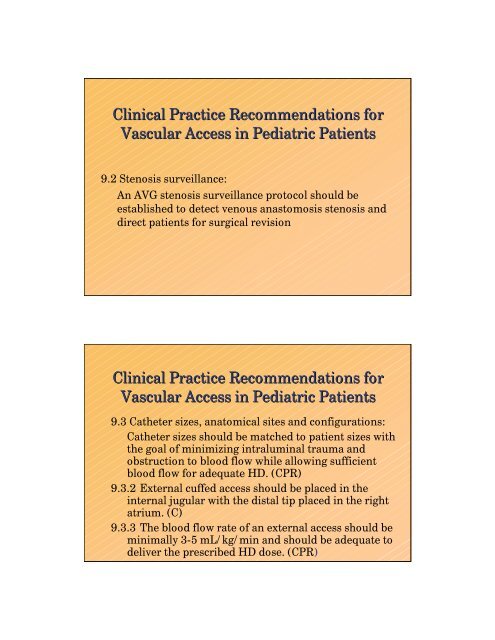Vascular Access in Hemodialysis: the 2006 KDOQI ... - Network 6
Vascular Access in Hemodialysis: the 2006 KDOQI ... - Network 6
Vascular Access in Hemodialysis: the 2006 KDOQI ... - Network 6
Create successful ePaper yourself
Turn your PDF publications into a flip-book with our unique Google optimized e-Paper software.
Cl<strong>in</strong>ical Practice Recommendations for<strong>Vascular</strong> <strong>Access</strong> <strong>in</strong> Pediatric Patients9.2 Stenosis surveillance:An AVG stenosis surveillance protocol should beestablished to detect venous anastomosis stenosis anddirect patients for surgical revisionCl<strong>in</strong>ical Practice Recommendations for<strong>Vascular</strong> <strong>Access</strong> <strong>in</strong> Pediatric Patients9.3 Ca<strong>the</strong>ter sizes, anatomical sites and configurations:Ca<strong>the</strong>ter sizes should be matched to patient sizes with<strong>the</strong> goal of m<strong>in</strong>imiz<strong>in</strong>g <strong>in</strong>tralum<strong>in</strong>al trauma andobstruction to blood flow while allow<strong>in</strong>g sufficientblood flow for adequate HD. (CPR)9.3.2 External cuffed access should be placed <strong>in</strong> <strong>the</strong><strong>in</strong>ternal jugular with <strong>the</strong> distal tip placed <strong>in</strong> <strong>the</strong> rightatrium. (C)9.3.3 The blood flow rate of an external access should bem<strong>in</strong>imally 3-5 mL/kg/m<strong>in</strong> and should be adequate todeliver <strong>the</strong> prescribed HD dose. (CPR)










